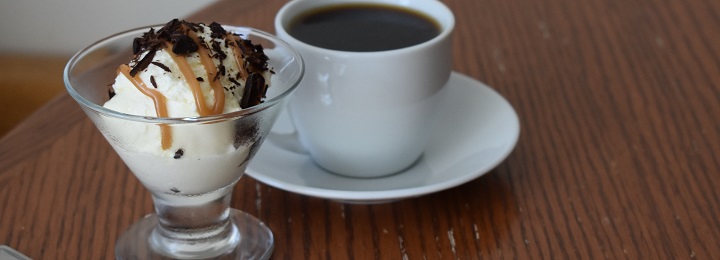 With the steamy days of summer upon us, what better way to cool down than with a delicious ice cream cone, right?
With the steamy days of summer upon us, what better way to cool down than with a delicious ice cream cone, right?
Sadly, wrong.
Unfortunately, ice cream doesn’t have quite the cooling effect we think it does. Applied Human Nutrition professor and food researcher at Mount Saint Vincent University Dr. Bohdan Luhovyy explains the science behind the sweet treat.
It’s all about the ingredients
To better understand why ice cream doesn’t cool us down, we must first understand what goes into it. “In Canada, we have very specific regulations for dairy products, including ice cream,” says Bohdan. “According to Canadian Food and Drug Regulations, ice cream must contain at least 10% milk fat. The predominant ingredients in most ice cream products are milk fat and sugar. When fat is broken down in the body, it releases a significant amount of heat. This process is called diet-induced thermogenesis. Compared to other nutrients, fats have the highest energy and therefore have a potential to release heat in the body.”
But those first few moments of relief when enjoying an ice cream cone on a hot day are not entirely a figment of your imagination. When we ingest ice cream, we feel cool sensations due to receptors in our mouth and the gastrointestinal tract that recognize the cold temperature.
Bohdan explains: “Sensory characteristics like a cooling effect on our tongue, the flavour and overall sweetness contribute to the positive experience of enjoying this treat. However, once the components of the ice cream start to break down, the cooling effect is diminished. The milk fat and sugar produce heat in the body and when the temperature outside is high, this extra heat will not keep us cool but instead have the opposite effect.”
Alternate ways to beat the heat
So if ice cream is not the cooling agent we’d hoped for, what are some other tasty treats that can help beat the heat?
According to Bohdan, consuming water is the best solution. Carbonated water beverages are also a nice alternative for their “fizz factor”. Consuming vegetables (like cucumbers and tomatoes) is also a great way to ensure you are getting enough fluid as they do not produce much heat in the body and have a high moisture content (if you really want something frozen, Bohdan suggests making your own popsicles at home with fruits and vegetables). There are also herbs, like mint that can have a cooling effect on the body.
“Fresh mint is sold in many grocery stores and you can easily make a drink with mint and lime or lemon using cold spring or carbonated water. Again, it’s important not to add sugar to avoid the extra energy and heat produced by sugar breakdown.”
Surprisingly, cayenne pepper may also produce cooling effects. “Cayenne pepper contains a component called capsaicin which stimulates sweat glands and can make us feel cooler. On the other hand, capsaicin stimulates thermogenesis and is known for its ‘fat burning’ effect so more research is needed to better understand these processes,” says Bohdan.
Fermented dairy beverages
Ayran is a savoury carbonated dairy drink, not yet well-known in Canada, but a good dairy-based substitute for ice cream. “These products are consumed in other parts of the world such as Turkey and Armenia. Because they are fermented, similarly to yogurt, they produce a cooling effect.” Bohdan says people can make this product at home by using plain kefir and mixing it with chopped dill, cucumber, parsley leaves, mint and a pinch of salt. “It is a perfect way to combat the heat.”

Careful what you drink
Bohdan also notes that people should be careful not to consume too many products that have a diuretic effect.
“Products like iced-coffee or beer may be promoted to us as having a cooling effect, but these products contain ingredients that deplete fluid from our bodies. Despite feeling a cooling sensation in our mouths, these products make us urinate more frequently and we lose water as a result. If we have less water to sweat, then we will not feel as cool.”
Are ice cream substitutes better for us?
Another note about cold dairy desserts: many ice cream substitutes may not be healthier for you, as many of the ingredients used in these alternative products have a higher carbohydrate content, which breaks down to more starch and sugar. “These products may increase blood glucose and could present risk for people with type 2 diabetes for example,” says Bohdan.
Are there some less desirable ingredients in ice cream too? Sure. But Bohdan reminds that it’s all about balance and keeping the serving size in mind. “There is a perception that high fructose corn syrup is a dangerous food component, but it’s important to know that it has a very similar composition to table sugar containing both glucose and fructose. Also, think about serving size. A serving size of ice cream is ½ cup and on average people will consume ¼ to 1 cup, which is not a danger zone for consuming fructose for most people.”
While the non-cooling news about ice cream may come as a disappointment, Bohdan does not suggest boycotting it entirely. In fact, he’s an ice cream fan himself and even makes his own waffle cones at home. When asked to name his favorite ice cream, he answers with a smile: “I love coffee flavoured ice cream with citrus notes, but the best ice cream I have ever tasted was in Verona, Italy. It was raspberry mandarin. The taste, flavour and texture were delicious!”
Finding better food products
When Bohdan isn’t exploring new ice cream shops with his family, he is busy teaching at MSVU and developing new food products that have a reduced level of risk associated with chronic diseases. Most recently, he has been testing the sensory properties of chocolate milk with reduced added sugar content and has been doing similar work with yogurt. (Bohdan is currently recruiting people for a new study on chocolate milk, yogurt, and snack products. If you are interested in participating, email Appetite.Study@msvu.ca.)
“I’m looking at how these reduced sugar products influence blood glucose levels and body weight. Food product development is an interesting area to explore because there are almost 60,000 products sold in the grocery store. Every year there are many products launched to the market that fail because of their lack of affordability or unpleasant taste. We are looking to develop tasty foods that are accessible, affordable, and also meet Health Canada recommendations regarding sodium, fat and sugar content.”
The ultimate goal of Bohdan’s research and teaching is to provide better knowledge of health effects associated with foods and to translate this knowledge from the lab to the community.